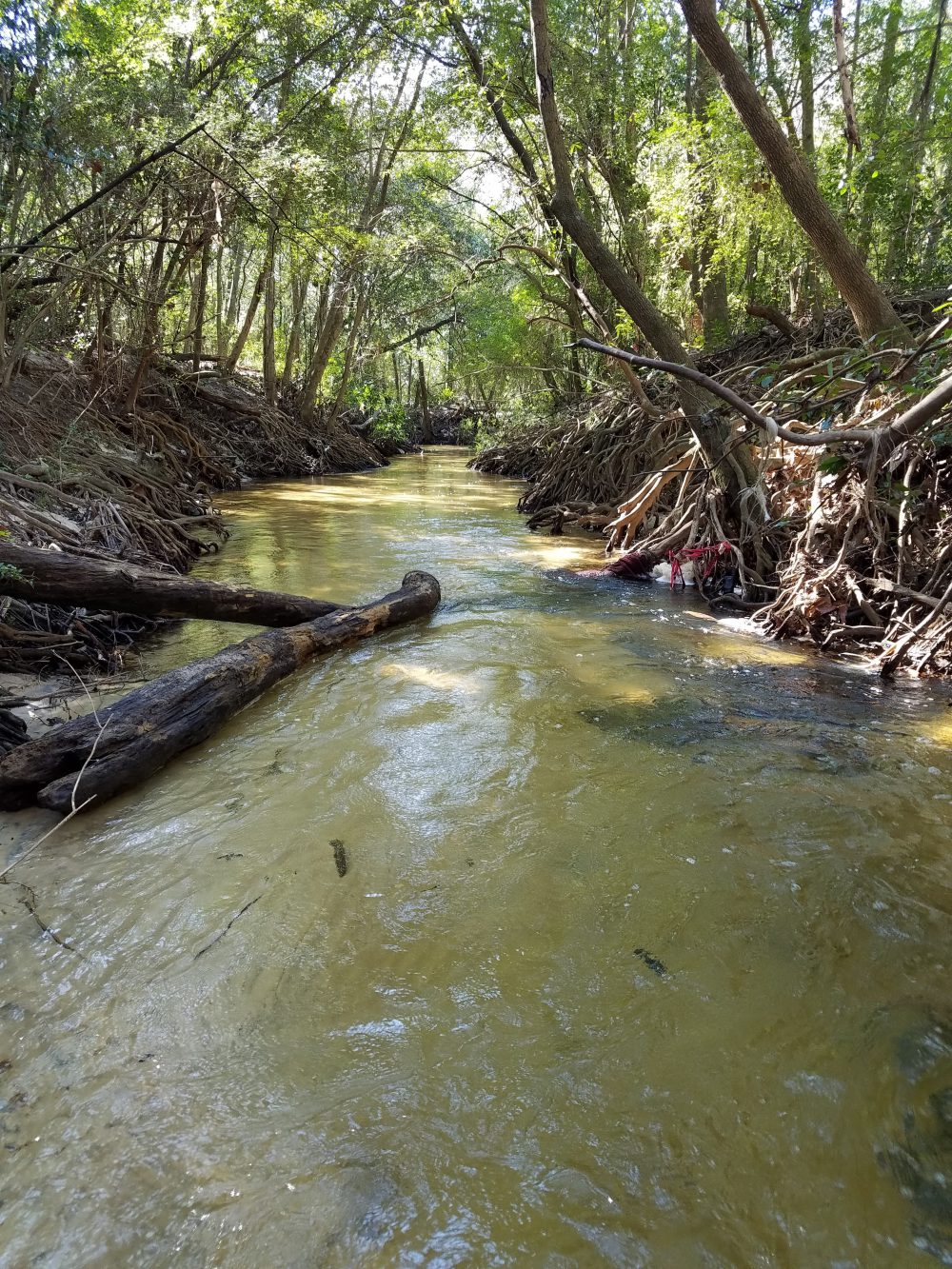
by Rick O'Connor | Jul 29, 2017
ARTICLE BY DR. MATT DEITCH; water quality specialist – University of Florida Milton
Summer is a great time for weather-watching in the Florida panhandle. Powerful thunderstorms appear out of nowhere, and can pour inches of rain in an area in a single afternoon. Our bridges, bluffs, and coastline allow us to watch them develop from a distance. Yet as they come closer, it is important to recognize the potential danger they pose—lightning from these storms can strike anywhere nearby, and can cause fatality for a person who is struck. Nine people were killed by lightning strike in Florida in 2016 alone, more than in any other state. Because of the risk posed by lightning, my family and I enjoy these storms up-close from indoors.
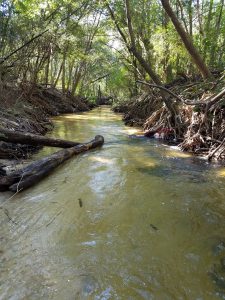
Carpenter’s Creek in Pensacola
Photo: Dr. Matt Deitch
A fraction of the rain that falls during these storms is delivered to our bays, bayous, and estuaries through a drainage network of creeks and rivers. This streamflow serves several important ecological functions, including preventing vegetation encroachment and maintaining habitat features for fish and amphibians through scouring the streambed. High flows also deposit fine sediment on the floodplain, helping to replenish nutrients to floodplain soil. On average, only about one-third of the water that falls as rain (on average, more than 60 inches per year!) turns into streamflow. The rest may either infiltrate soil and percolate into groundwater; or be consumed and transpired by plants; or evaporate off vegetation, from the soil, or the ground surface before reaching the soil. Evaporation and transpiration play an especially large role in the water cycle during summer: on average, most of the rain that falls in the Panhandle occurs during summer, but most stream discharge occurs during winter.
The water that flows in streams carries with it many substances that accumulate in the landscape. These substances—which include pollutants we commonly think of, such as excessive nutrients comprised of nitrogen and phosphorus, as well as silt, oil, grease, bacteria, and trash—are especially abundant when streamflow is high, typically during and following storm events. Oil, grease, bacteria, and trash are especially common in urban areas. The United States EPA and Florida Department of Environmental Protection have listed parts of the Choctawhatchee, St. Andrew, Perdido, and Pensacola Bays as impaired for nutrients and coliform bacteria. Pollution issues are not exclusive to the Panhandle: some states (such as Maryland and California) have even developed regulatory guidelines in streams (TMDLs) for trash!
Many local and grassroots organizations are taking the lead on efforts to reduce pollution. Some municipalities have recently publicized efforts to enforce laws on picking up pet waste, which is considered a potential source of coliform bacteria in some places. Some conservation groups in the panhandle organize stream debris pick-up days from local streams, and others organize volunteer citizens to monitor water quality in streams and the bays where they discharge. Together, these efforts can help to keep track of pollution levels, demonstrate whether restoration efforts have improved water quality, and maintain healthy beaches and waterways we rely on and value in the Florida Panhandle.
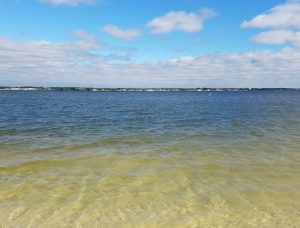
Santa Rosa Sound
Photo: Dr. Matt Deitch

by Andrea Albertin | Apr 29, 2017
One third of homes in Florida rely on septic systems, or onsite sewage treatment and disposal systems (OSTDS), to treat and dispose of household wastewater, which includes wastewater from bathrooms, kitchen sinks and laundry machines. When properly maintained, septic systems can last 25-30 years, and maintenance costs are relatively low.
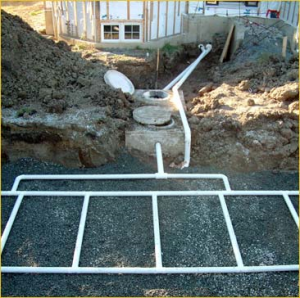
A conventional residential septic tank and drain field under construction.
Photo: Andrea Albertin
A general rule of thumb is that with proper care, systems need to be pumped every 3-5 years at a cost of about $300 to $400. Time between pumping does vary though, depending on the size of your household, the size of your septic tank and how much wastewater you produce. If systems aren’t maintained they can fail, and repairs or replacing a tank can cost anywhere between $3000 to $10,000. It definitely pays off to maintain your septic system!
The most common type of OSTDS is a conventional septic system, which is made up of a septic tank (a watertight container buried in the ground) and a drain field, or leach field. The septic tank’s job is to separate out solids (which settle on the bottom as sludge), from oils and grease, which float to the top and form a scum layer. The liquid wastewater, which is in the middle layer of the tank, flows out through pipes into the drainfield, where it percolates down through the ground.
Although bacteria continually work on breaking down the organic matter in your septic tank, sludge and scum will build up, which is why a system needs to be cleaned out periodically. If not, solids will flow into the drainfield clogging the pipes and sewage can back up into your house. Overloading the system with water also reduces its ability to work properly by not leaving enough time for material to separate out in the tank, and by flooding the system. Sewage can flow to the surface of your lawn and/or back up into your house.
Failed septic systems not only result in soggy lawns and horrible smells, but they contaminate groundwater, private and public supply wells, creeks, rivers and many of our estuaries and coastal areas with excess nutrients, like nitrogen, and harmful pathogens, like E. coli.
It is important to note that even when traditional septic systems are maintained, they are still a source of nitrogen to groundwater; nitrate is not fully removed from the wastewater effluent.
How can you properly care for your septic system?
Here are a some basic tips to keep your system working properly so that you can reduce maintenance costs by avoiding system failure, and so that you can reduce your household’s impact on water pollution in your area.
- Don’t flush trash down the toilet. Only flush regular toilet paper. Toilet paper treated with lotion forms a layer of scum. Wet wipes are not flushable, although many brands are labelled as such. They wreak havoc on septic systems! Avoid flushing cigarette butts, paper towels and facial tissues, which can take longer to break down than toilet paper.
- Think at the sink. Avoid pouring oil and fat down the kitchen drain. Avoid excessive use of harsh cleaning products and detergents, which can affect the microbes in your septic tank (regular weekly or so cleaning is fine). Prescription drugs and antibiotics should never be flushed down the toilet.
- Limit your use of the garbage disposal. Disposals add organic matter to your septic system, which results in the need for more frequent pumping. Composting is a great way to dispose of your fruit and vegetable scraps instead.
- Take care at the surface of yourtank and drainfield. To work well, a septic system should be surrounded by non-compacted soil. Don’t drive vehicles or heavy equipment over the system. Avoid planting trees or shrubs with deep roots that could disrupt the system or plug pipes. It is a good idea to grow grass over the drainfield to stabilize soil and absorb liquid and nutrients.
- Conserve water. You can reduce the amount of water pumped into your septic tank by reducing the amount you and your family use. Water conservation practices include repairing leaky faucets, toilets and pipes, installing low cost, low-flow showerheads and faucet aerators, and only running the washing machine and dishwasher when full. In the US, most of the household water used is to flush toilets (about 27%). Placing filled water bottles in the toilet tank is an inexpensive way to reduce the amount of water used per flush.
- Have your septic system pumped by a certified professional. The general rule of thumb is every 3-5 years, but it will depend on household size, the size of your septic tank and how much wastewater you produce.
By following these guidelines, you can contribute to the health of your family, community and environment, as well as avoid costly repairs and septic system replacements.
You can find excellent information on septic systems a the US EPA website: https://www.epa.gov/septic. The Florida Department of Health website provides permiting information for Florida and a list of certified maintenance entities by county: http://www.floridahealth.gov/Environmental-Health/onsite-sewage/index.html.
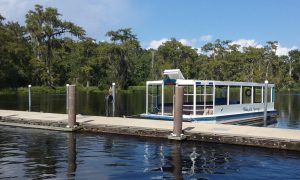
The Department of Environmental Protection (FDEP) identified septic systems as the major source of nitrate in Wakulla Springs, located in Wakulla County. Excess nitrate is thought to promote algal growth, leading to the degradation of the biological community in the spring.
Photo: Andrea Albertin
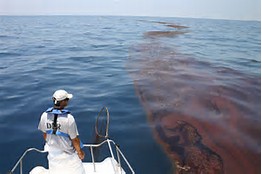
by Rick O'Connor | Apr 14, 2017

The Deepwater Horizon Oil Spill was one of the worst natural disasters in our country’s history.
Photo: Gulf Sea Grant
We are pleased to announce the release of a pair of new bulletins outlining how the 2010 Deepwater Horizon oil spill impacted the popular marine animals dolphins and sea turtles. To read these and other oil spill science publications, go to http://gulfseagrant.org/oilspilloutreach/publications/.
The Deepwater Horizon’s impact on bottlenose dolphins – In 2010, scientists documented a markedly increased number of stranded dolphins in the northern Gulf of Mexico. Was oil exposure to blame? Could other factors have been in play? Read the answers to these questions here: http://masgc.org/oilscience/oil-spill-science-dolphins.pdf.
Sea turtles and the Deepwater Horizon oil spill – This publication reviews the estimated damage oil exposure caused to sea turtles and discusses continued research and monitoring efforts for these already endangered and threatened species. Click here to read this bulletin: http://masgc.org/oilscience/oil-spill-science-sea-turtles.pdf.
Also –
“Sea turtles and oil spills” presentations – On March 23 in Brownsville, Texas, more than 100 participants gathered in person and online to listen to scientists, responders, and sea turtle specialists explain what we know about how these creatures fared in 2010 and detail ongoing conservation programs. Watch videos of the presentations here: http://gulfseagrant.org/sea-turtles-oil-spills/.
Our oil spill science outreach team hopes you will find these resources useful! J
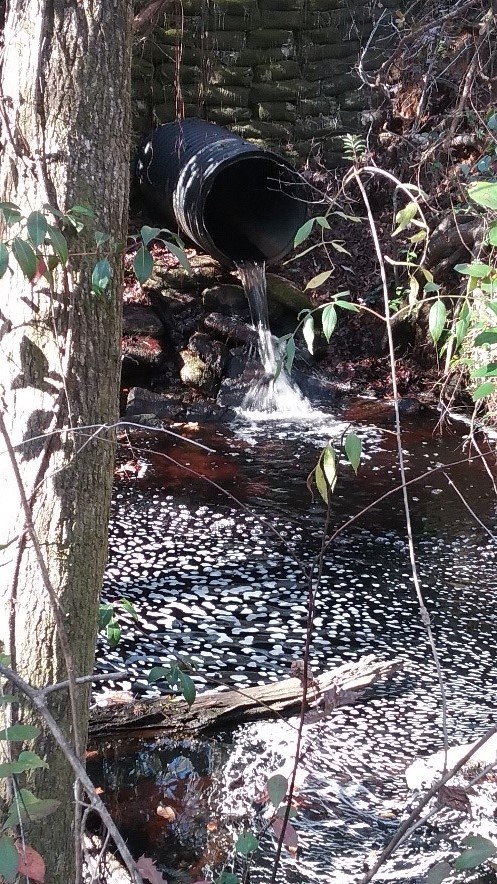
by Andrea Albertin | Mar 11, 2017
Stormwater runoff is water from rainfall that flows along the land surface. This runoff usually finds its way into the nearest ditch or water body, such as a river, stream, lake or pond. Generally speaking, in natural undeveloped areas only 10% of rainfall is runoff. About 40% returns to the atmosphere though evapotranspiration, which is the water evaporated from land and plant surfaces plus water lost directly from plants to the atmosphere through their leaves. The remaining 50% of rainfall soaks into the ground, supporting vegetation, contributing to streamflow and replenishing groundwater resources. In Florida, where 90% of the population relies on groundwater for their drinking water, aquifer recharge from infiltrating rainwater is vital.
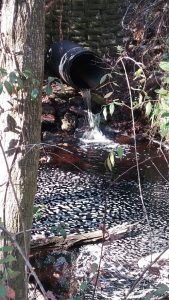
Stormwater runoff from a drainage pipe flowing into a creek.
Photo: Andrea Albertin
As landscapes become more developed, areas that use to absorb rainwater are replaced by impervious surfaces like rooftops, driveways, parking lots and roads. Additionally, we are levelling our land, removing natural depressions in the landscape that trap rainwater and give it time to seep back into the ground. As a result, a higher percentage of rainfall is becoming runoff and which flow at faster rates into storm drainages and nearby water bodies instead of soaking into the soil.
A major problem with stormwater runoff is that as it flows over surfaces, it picks up potential pollutants that end up in our waterways. These include trash, sediment, fertilizer and pesticides from lawns, bacteria from dog waste, metals from rooftops, and oil from parking lots and roads. Stormwater runoff is often the main cause of surface water pollution in urban areas.
Luckily, there are ways in which we can all help slow the flow and reduce stormwater runoff. These reductions can give rainfall more time to soak back into the ground and replenish our needed stores of groundwater.
What can you do to help “slow the flow” of stormwater?
The UF/IFAS Florida Friendly Landscaping Program provides the following recommendations that you, as a homeowner, can do to reduce stormwater runoff from your property:
- Direct your downspouts and gutters to drain onto the lawn, plant beds, or containment areas, so that rain soaks into the soil instead of running off the yard.
- Use mulch, bricks, flagstone, gravel, or other porous surfaces for walkways, patios, and drives.
- Reduce soil erosion by planting groundcovers on exposed soil such as under trees or on steep slopes
- Collect and store runoff from your roof in a rain barrel or cistern.
- Create swales (low areas), rain gardens or terracing on your property to catch, hold, and filter stormwater.
- Pick up after your pets.
- Clean up oil spills and leaks on the driveway. Instead of using soap and water, spread cat litter over oil, sweep it up and then throw away in the trash.
- Sweep grass clippings, fertilizer, and soil from driveways and streets back onto the lawn. Remove trash from street gutters before it washes into storm drains. The City of Tallahassee’s TAPP (Think About Personal Pollution) Campaign is another excellent resource for ways in which you can help reduce stormwater runoff (http://www.tappwater.org/).
- For more information on stormwater management on your property and other Florida Friendly Landscaping principles, you can visit the Florida Friendly Landscaping website at: https://ffl.ifas.ufl.edu.
TAPP also provides a manual for homeowners on how to build a raingarden, which can be found at http://tappwaterapp.com/what-can-i-do/build-a-rain-garden/. Raingardens are small depressions (either naturally occurring or created) that are planted with native plants. They are designed to temporarily catch rainwater, giving it time to slowly soak back into the ground.
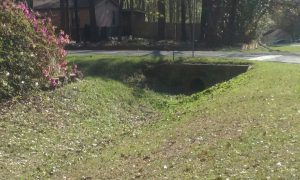
Grass covered drainage ditches slow the flow of stormwater runoff and allow more rainwater to soak back into the ground.
Photo: Andrea Albertin
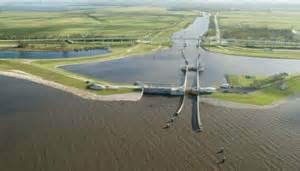
by Rick O'Connor | Jul 31, 2016
Most of us have heard about the toxic algal blooms plaguing south Florida waters. If not, check out http://www.cnbc.com/2016/07/05/. This bloom has caused several major fish kills, bad odors, and has kept tourist away from the area. What happen? and could it happen in the panhandle?

One of the many lock systems that controls water flow in Lake Okeechobee.
Photo: Florida Sea Grant
First we have to understand what happened in south Florida. The source of the problem is Lake Okeechobee. This large freshwater lake has been diked and channeled over the years to supply water to cities and farms in south Florida. The flow of water in and out of the lake is controlled by the Army Corp of Engineers. Typically, this time of year they manage the level of water within the lake to prepare for both the rainy and hurricane seasons. To do this they allow water to flow out into local rivers and canals. However, the water within the lake is heavy with nutrients. Fertilizers, leave matter, and animal waste are discharged into the lake from neighboring communities and agriculture fields. These nutrients fuel the rapid growth of plants and algae, which we call a bloom. These blooms can contain toxic forms of algae that can cause skin irritation and intestinal problems in humans, and can kill many forms of wildlife. Because the state is trying to restore the Everglades, lake water that test high for nutrients cannot be released in a southern direction but rather east and west towards the populated coasts.
But this year was different…
Due to heavy rainfall in spring the Corp had to release more water than they typically would. It was after this release that the large blooms along the east coast began to occur. The state declared a state of emergency and the flow of water out of the lake was altered. But for east Florida, the damage was done.
Could this happen in other parts of the state? Could it happen in the panhandle?
Well first, we have very few controlled water systems for drinking water (reservoirs) so that exact same scenario is a low probability. During a recent trip out west I camped several times along a reservoir designed to hold drinking water for municipalities. At each there were information signs warning swimmers about the potential of high levels of toxic cyanobacteria, particularly in late summer and early fall. But here most of our rivers flow unimpeded (relatively) to the Gulf of Mexico. Our drinking water instead comes from the ground.
But could our local waterways become contaminated with algae?
Yes…
With the situation going on in south Florida people of have pointed fingers at the Corp for releasing too much water. But because the water had high levels of nutrients, others have pointed the finger at the fact that we do not regulate nutrient discharge as well as we should. We have cities and farms here as well, and each produce and release nutrients in the form of leaf litter, animal waste, and fertilizers. Actually large fish kills have happened here. I remember seeing large masses of dead fish on the surface of Bayou Texar in Pensacola when I was younger; Bayou’s Chico and Grande had their problems as well. Most of these were due to excessive nutrients being released from developed areas in the local municipalities.
When I first joined Sea Grant I was told that water quality was a concern in the Pensacola area. Many remembered these large fish kills from a few decades ago and were still concerned about the quality of water in our area, particularly the bayous. I have worked with local non-profits, as well as state and county agencies, and the local high schools to monitor nutrients in the area. The nutrient of concern here is nitrogen. Several groups including the Bream Fishermen’s Association, Escambia County, UF/IFAS LAKEWATCH, and the School District’s Marine Science Academy routinely monitor for nitrogen. Others, such as the University of West Florida and the U.S. EPA, do so when they are working on such projects. Low nitrogen levels could mean less being discharged, but it could also mean that the algae have consumed it – so monitoring for chlorophyll (indicator for the presence of algae) is also important; and these groups do this as well. High levels of algae can trigger declines in dissolved oxygen, so this is monitored also. Low dissolved oxygen can trigger fish kills, and this data is collected by the Florida Fish and Wildlife Conservation Commission. I try to collect as much of this data as I can and post it on our website each Friday on the Escambia County Extension website.
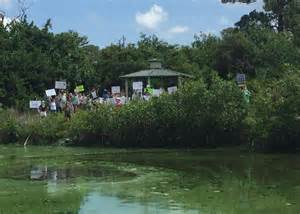
A large algal bloom in a south Florida waterway.
Photo: University of South Florida News
Yes, we have areas with relative high levels of nitrogen, when compared to other locations sampled. Dissolved oxygen levels are typically okay in the Pensacola Bay area, but most of the monitors are sampling in shallow water near shore. A UF/IFAS LAKEWATCH volunteer has recently started to monitor DO at depth in Perdido Bay. In the Pensacola Bay area, fish kills are down when compared to earlier decades.
2016 panhandle fish kills based on data from FWC
- Escambia/Santa Rosa Counties – 8 fish kills – 312 dead fish – cause for most is unknown
- Okaloosa/Walton – 12 fish kills – 1102 dead fish – cause for most is unknown
- Bay – 13 fish kills – 3092 dead fish – 3 of these were attributed to low DO – 2 in White Western Lake, 1 in Grand Lagoon
- Gulf – 5 fish kills – 719 dead fish – cause for most is in unknown – most were starfish
- Franklin – 1 dead sturgeon at St. Vincent Island
- Wakulla – 2 fish kills – 200 dead fish – cause was fishing net dump
- Jefferson – reported no fish kills so far this year.
There are fish kills occurring, the cause of most is unknown, but the numbers are much lower than they were a few decades ago and many are not related to the nutrient issue. However it is true that not all fish kills are reported to FWC. Many residents who discover one are not sure who to call or where to report. If you do discover a fish kill you can report it to the FWC at http://myfwc.com/research/saltwater/health/fish-kills-hotline/. We also experienced a large red tide event this past fall. Though red tides do occur naturally, and 2015 was an El Nino year with unusual rainfall patterns, they can be enhanced with increase nutrients in the run-off.
What we do have a problem with in many areas of the panhandle coast are health advisories. Some agencies, FDEP and Escambia County, monitor for fecal coliform bacteria locally. These are bacteria associated with the digestive system of birds and mammals, including humans, and are non-toxic. However, they are indicators that animal waste is in the water and that pathogenic bacteria associated with animals could be also. When samples are collected the number of bacteria colonies are counted. If the number is above what is allowed a re-sample is taken. If the second count is high as well a health advisory is issued. Many coastal waterways in the panhandle are fighting this problem. Based on FDEP data, the bayous of the Pensacola area average between 8-10 advisories each year. Not all bodies of water are monitored at the same frequency but our bayous are issued advisories between 25-35% of the time they are sampled. Most of the advisories occur after a heavy rainfall, suggesting the source of the animal waste is from run-off, but it could be related to leaky septic tanks systems as well.
So though the scenario that is occurring in south Florida is a low risk for our area, we do have some concerns and there are many things residents and citizens can do to help reduce the risk of a large problem occurring.
- Manage the amount of fertilizer you use. Whether you are a farmer, a lawn care company, or property owner, think about how much you are using and use only what your plants need. For assistance on this, contact your extension office.
- Reduce leaf litter from entering waterways. When raking we recommend you bag your leaves using the new paper bags. These can be composted at the landfill. If you have large amounts of leaves that cannot be bagged, consider composting yourself. The demonstration garden at your local extension office can show you several methods of composting.
- Pick up your animal waste. Our streets and parks are littered with pet waste that owners have not removed, even with the city and county providing plastic bag dispensers to do so. Please be aware of the problem with animal waste and help keep our streets and waterways clean.
- If you have a septic tank, maintain it properly. If you are not sure how to do this, contact your local extension office for advice.
If you have questions about local water quality issues, contact your local county extension office.

by Scott Jackson | Jul 2, 2016
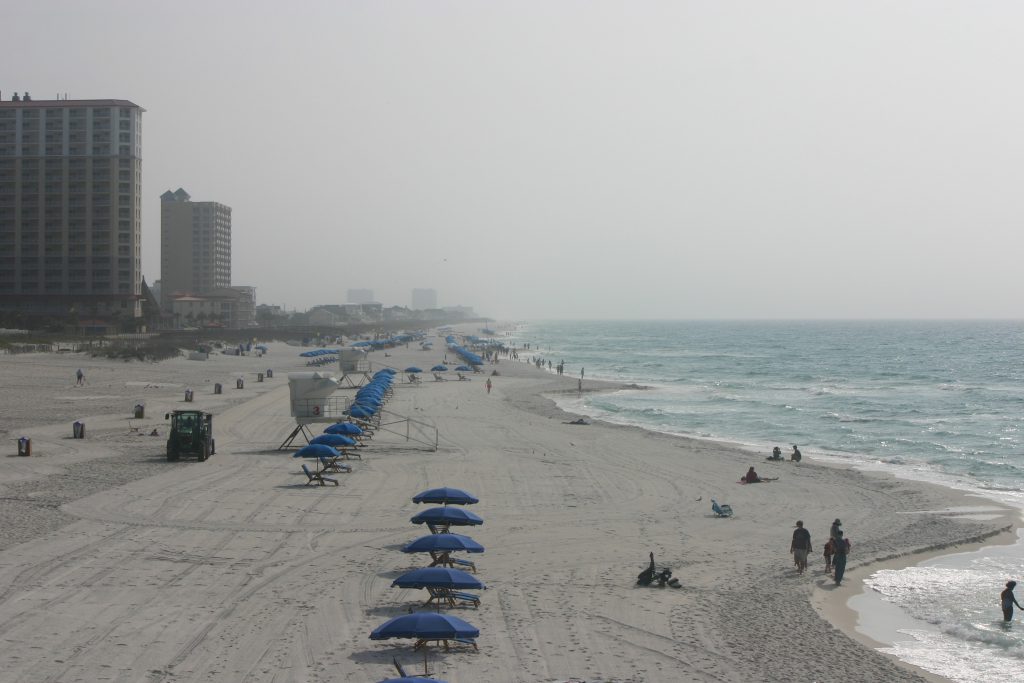
Recent news reports have Panhandle Beaches trending on social media. Beaches are open and ready for the holiday weekend. Here’s information to help make sure you are ready too. Photo by Florida Sea Grant.
The threat of bacteria in coastal waters can be scary and a challenge to understand. Here is information that helps clarify the threat to beach visitors and recreational users of marine waters. This is a good opportunity to think about bacteria exposure risks related to the coastal environment that we can control. It is important to remember the probability of severe illness in a normal healthy individual is very low.
There are two different un-related groups of bacteria species that often are cited in the news. One general group is fecal coliform and the other group are marine specific known as Vibrio.
Fecal coliform including Enterococci bacteria are used by public health managers as indicators of water quality. High levels of these bacteria can indicate an elevated health risk for beach visitors. For some individuals contact in impacted waters can result in gastrointestinal issues like nausea, vomiting, stomachache, diarrhea, headache or fever. Other symptoms might include rashes, sore throat, ear ache, and other cold-like or upper respiratory symptoms.
When “no-swimming” advisories are posted you can avoid these concerns by following warning and guidance information. Many times advisories are for specific locations due to storm run-off and water circulation patterns. If an area has a warning or is closed, usually there are better choices for swimming activities nearby. The Florida Department of Health has an established testing of many of Florida’s coastal swimming areas. The latest guidance information can be found at http://www.floridahealth.gov/environmental-health/beach-water-quality
On the other hand, Vibrio exposure that results in illness is potentially more severe. The US Centers for Disease Control and Prevention now estimate 80,000 Vibrio illnesses and 100 deaths occur annually in the United States. In perspective, The Clean Beaches Coalition estimates 180 million Americans annually make 2 billion visits to ocean, gulf and inland beaches.
According Georgia Sea Grant’s SafeOysters.org website and research, many Vibrio infections are not reported and usually do not cause serious or life-threatening illness in healthy people, although they may cause gastroenteritis (nausea, abdominal pain, vomiting, and/or diarrhea) or cellulitis (skin infection). For a Vibrio infection to occur there must be an entry point into the body. This usually is either through water entering an open wound or eating raw or undercooked seafood.
Symptoms of infection due to consumption of raw or undercooked seafood often develop in 12 to 48 hours and may include:
-
Fever/chills
-
Nausea/stomach pain/vomiting
-
Diarrhea
Individuals with weakened immune systems, chronic diseases or conditions, or undergoing certain medical treatments (see list below) are more susceptible to Vibrio vulnificus infections and are also more likely to become seriously ill or die from them. The fatality rate may be as high as 61% for Vibrio vulnificus infections in people that have been diagnosed with one or more of the following health conditions:
-
Liver disease (from cirrhosis, hepatitis, or cancer)
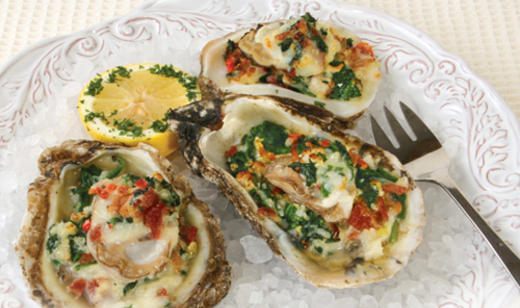
No need to feel left out! Fully cooked oyster dishes like Oysters Rockefeller are a coastal classic that’s safe and tastes great! Photo by Florida Department of Agriculture and Consumer Services.
-
Diabetes
-
Alcoholism
-
Kidney disease or failure
-
Cancer (includes lymphoma, leukemia, and Hodgkin’s disease)
-
HIV/AIDS
-
Stomach disorders including surgery, taking acid reflux medication or antacids
-
Hemochromatosis (iron overload disease)
* If you are unsure of your risk, consult your doctor. You can always indulge in great oyster recipes that are fully cooked like Oyster Rockefeller or oyster chowder.
Perhaps one of the most common group of listed individuals are those taking acid reflux or heartburn medications. This would also include antacids and prescription medications for acid reflux and other common digestive conditions. Many of these medications work by reducing acid which can potentially increase pH in the digestive system. This lowers the natural defense barrier to several foodborne bacteria including Vibrio. If you take these medications do not eat raw or under cooked seafood. If you have any question about your risk, consult your doctor.
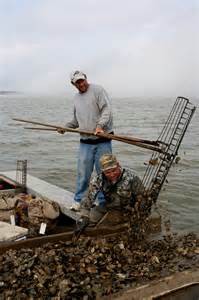
An oysterman uses his 11 foot long tongs to collect oysters from the bottom of Apalachicola Bay
Photo: Sea Grant
As mentioned earlier, Vibrio can also enter the body through open wounds. Vibrio is sometimes misnamed as “flesh-eating” bacteria. “Flesh-eating” is not a medical term and was likely derived from the fact that tissue death, or necrosis, can occur during advanced, late stages of infection around a wound if it is left untreated, especially in those with weakened immune systems (Oliver 2005). The best advice is to seek medical attention early if you experience any of these symptoms or have suffered cut or puncture injury in coastal waters. (See Vibrio FAQs from UF/IFAS and Florida Sea Grant)
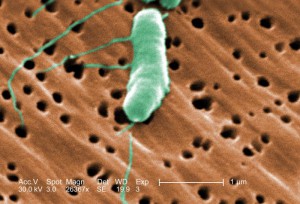
The rod-shaped bacterium known as Vibrio. Courtesy: Florida International University
Wound infection symptoms may develop within 3 to 24 hours and include:
-
Rapid swelling, pain, and reddening of skin around wound (present in 100% of infections)
-
Large blisters, die-off of tissue around wound (30 – 50% of infections)
-
Gangrene (<10%)
If Vibrio vulnificus infections are left untreated in people at risk for serious infection, symptoms may quickly increase in severity and include:
-
Fluid accumulation, especially in legs
-
Blood-filled large blisters, mainly on extremities
-
Septicemia (bacteria enter and spread through blood stream)
-
Shock (rapid drop in blood pressure)
-
Death
For additional information and details please visit SafeOysters.org
Here are some final thoughts and advice:
-
Remember the majority of healthy individuals will not have any problems.
-
If you are recovering from illness know your limits and use the above resources to make informed decisions to protect your health.
-
Plan your beach vacation for safety but then confidently relax and enjoy the experience.
-
For additional beach safety and enjoyment of our natural resources see our other articles on the UF/IFAS Panhandle Outdoors website.
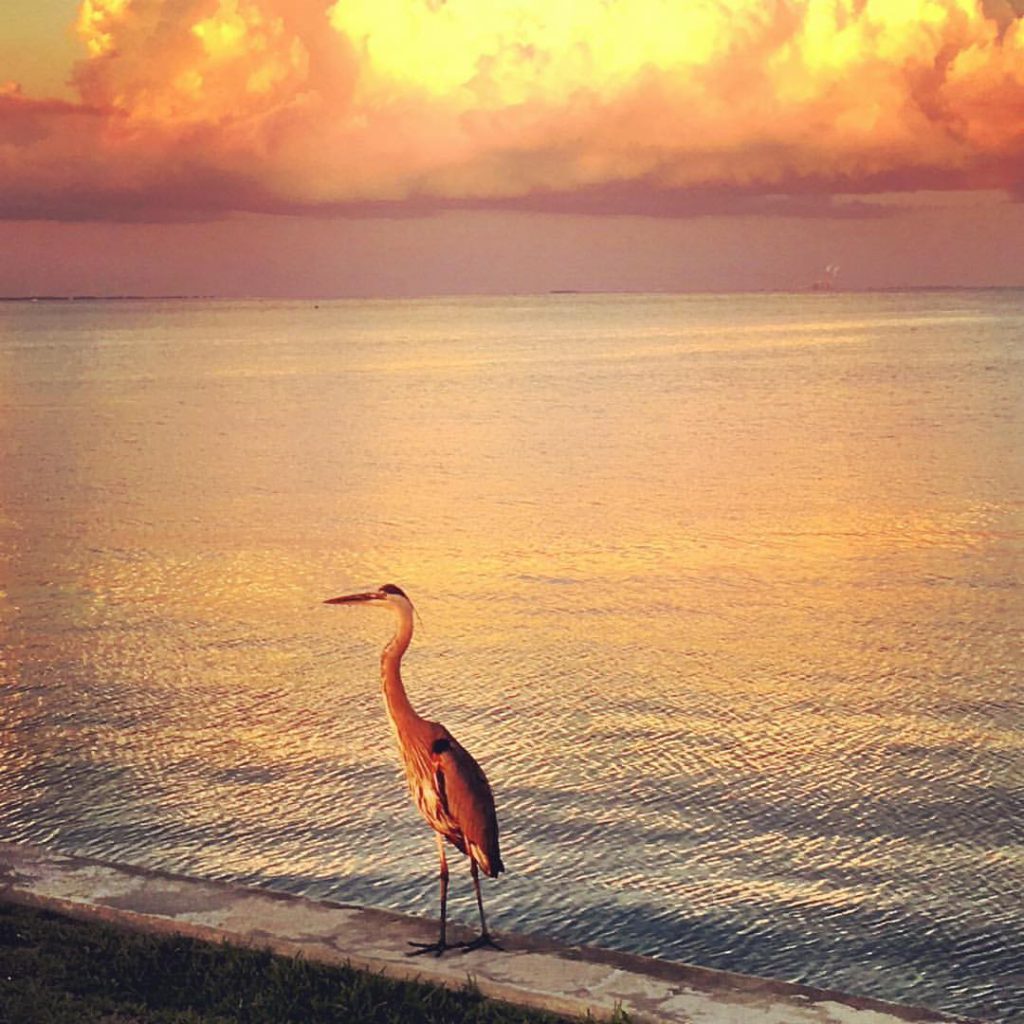
A great blue heron at sunset stalks the shoreline ready for his next meal. Scenes like this await coastal visitors. It’s an experience like nowhere else. Photo by the author.
An Equal Opportunity Institution. UF/IFAS Extension, University of Florida, Institute of Food and Agricultural Sciences, Nick T. Place, dean for UF/IFAS Extension. Single copies of UF/IFAS Extension publications (excluding 4-H and youth publications) are available free to Florida residents from county UF/IFAS Extension offices.


















